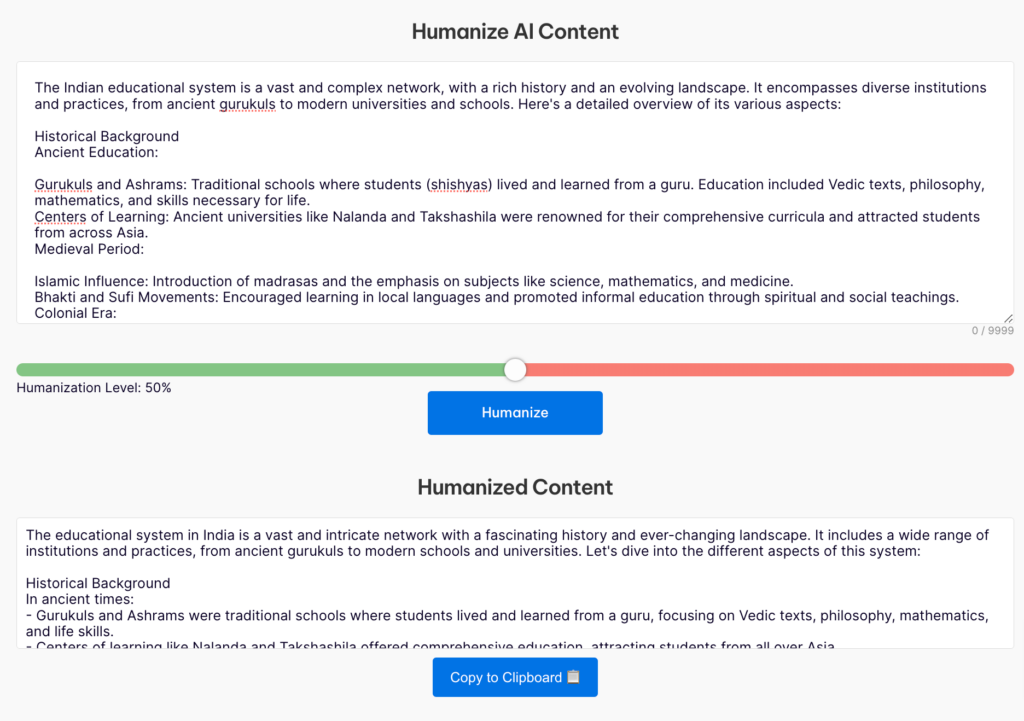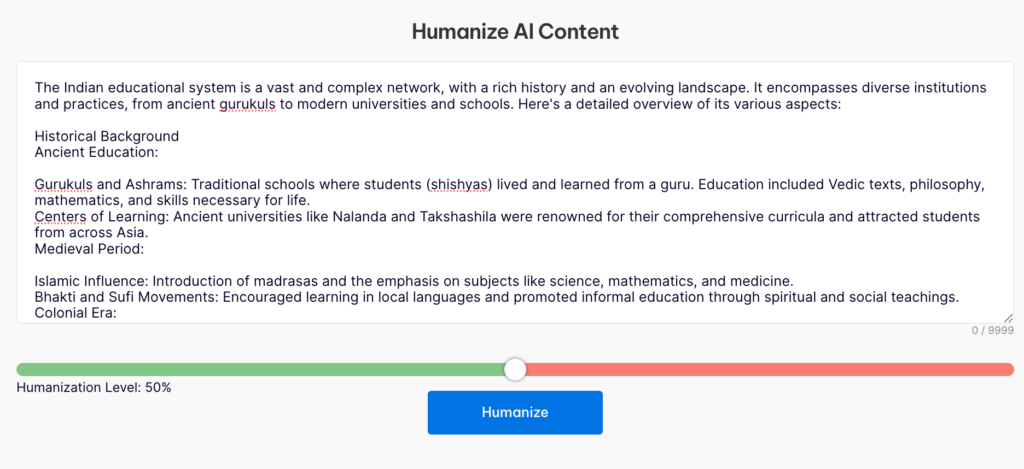5 Tips to Humanize AI Text

AI is transforming content creation, enabling rapid generation of text that is coherent, informative, and even engaging. However, AI-generated content often has the basic generic details about the topic and lacks the human touch, which is bad for SEO and making it crucial to add elements that make it feel more personal and relatable. Here are five tips to humanize AI text effectively.
Tip 1: Easy Way – Using Humanizing Tools
Neps AI Text Humanizer is one of the best tools to add a human touch to AI-generated text, creating content that is white hat SEO. This tool is particularly effective due to its range of features:
- AI Text Humanizer: Converts AI-generated text into human-like writing, ensuring your content feels genuine and relatable.
- Bypass AI Detectors: Allows content to effortlessly bypass AI detectors like Neps AI, Originality AI, Winston AI, GPTZero, and ZeroGPT.
- Plagiarism-Free Promise: Ensures 100% original human content, safeguarding your work from plagiarism.
- SEO-Friendly: Retains major keywords while optimizing content for search engines without compromising readability.
- Content Quality: Maintains content integrity, ensuring it is free of errors, typos, and odd phrasings.
- Interactive Sentence Alternatives: Allows real-time customization by providing sentence alternatives to match your desired tone and style (Coming Soon).
- Customizable Humanization Levels: Adjusts the level (0-100) of humanization to suit your needs, from slight tweaks to a complete overhaul.
- Content Safety and Security: Ensures complete privacy and security of your content. None of the data is saved.
How Neps AI Works?
- Input Content: Paste your AI-generated text into NepsAI’s dashboard.

- Humanize: Click the “Humanize” button to transform your content into seamless, human-like prose in seconds.

- Review & Tweak: Inspect the transformed content and make any necessary adjustments.
- AI Verification: Use the built-in AI detection tool to ensure your text passes AI detectors, guaranteeing originality and authenticity.
Tip 2: Breaking the AI Text Pattern
AI often follows certain patterns that can make its content feel repetitive and robotic. By understanding and breaking these patterns, you can make AI-generated text feel more human.
The Six Patterns of AI Generated Content:
- Repetitive Language:
AI tends to repeat phrases and uses formal language.
Example of AI generated content: “In conclusion, the role of AI in education is immense. It’s a groundbreaking tool changing the educational scene.”
- No Personal Touch:
AI lacks personal stories, making the content generic.
Example of AI generated content: “Using AI tools can boost study efficiency. Many students find these tools useful for organizing their schedules.”
- Inconsistent Tone:
AI can shift tones suddenly, making the content feel uneven.
Example of AI generated content: “AI in education is great for personalized learning. Teachers can also use these tools to understand student needs better. Moreover, AI in classrooms is the future.”
- Overused Phrases:
AI often repeats certain phrases, creating a monotonous feel.
Example of AI generated content: “AI technology is advancing quickly. It’s also key for personalized learning. Additionally, AI will significantly impact education.”
- Generic Examples:
AI uses vague examples lacking specific details.
Example of AI generated content: “AI can help by providing personalized feedback. For instance, it can highlight areas for improvement and suggest resources.”
- Predictable Structure:
AI content often follows a set structure, making it feel formulaic.
Example of AI generated content: “AI is changing many industries, including education. We’ll look at its benefits, challenges, and future. By the end, you’ll see why AI matters in education.”
How to Break AI Generated Text Patterns?
- Combine different AI patterns to create more varied and complex content.
- Integrate human-like nuances and varied sentence structures.
- Avoid overused AI phrases and incorporate more diverse vocabulary.
- Adding latest insights in the content.
Tip 3: Avoiding Commonly Used AI Words
AI often overuses certain words, making the content sound unnatural. By avoiding these commonly used words, you can create more authentic and engaging text.
Common AI Words to Avoid:
- Elevate
- Leverage
- Journey
- Resonate
- Explore
- Seamless
- Robust
- Ultimately
- Multifaceted
- Beacon
How to Avoid Overused AI Words?
- Use synonyms and varied expressions.
- Employ a thesaurus to find less common alternatives.
- Mix up sentence structures to create more dynamic content.
Examples:
- Replace “elevate” with “enhance” or “boost.”
- Use “utilize” instead of “leverage.”
- Swap “journey” with “path” or “adventure.”
- Change “resonate” to “connect” or “strike a chord.”
- Instead of “explore,” use “investigate” or “delve into.”
- Replace “seamless” with “smooth” or “uninterrupted.”
- Use “sturdy” or “resilient” instead of “robust.”
- Swap “ultimately” with “in the end” or “finally.”
- Instead of “multifaceted,” use “complex” or “diverse.”
- Replace “beacon” with “guide” or “light.”
Tip 4: Adding Human Touch to Content or QC by a Content Editor
Humanizing the AI-generated content involves understanding your audience, personalizing content, and incorporating personal opinions and thoughts.
Steps to Add Human Touch:
- Understand Your Audience: Create content that addresses their specific needs, interests, and pain points.
- Personalize Content: Use data to tailor the content to individual preferences and contexts.
- Infuse Personal Opinions: Add personal insights and experiences to make content relatable.
- Leverage Expertise: Incorporate expert quotes and data to enhance credibility.
- Use Conversational Language: Write in a way that feels natural and engaging.
- Review and Edit: Thoroughly review AI-generated content to correct errors and adjust tone.
Examples:
- Adding user feedback in product reviews.
- Personal anecdotes in blog posts to connect with readers.
- Expert quotes in technical articles for credibility.
- Conversational tone in newsletters to engage subscribers.
- Editing AI-generated content for tone consistency.
- Using user-generated content in social media posts for authenticity.
- Customizing content based on audience demographics and psychographics.
Tip 5: Using Best Content Prompts
Crafting effective prompts for AI can significantly enhance the quality of the generated content. Well-thought-out prompts guide the AI to produce more accurate and relevant text.
Effective Prompts for AI Content Creation:
- Blog Content: “Create a list of the top trends in [industry] in [year].”
- SEO Content: “Generate a blog post outline on the topic [topic] with subheadings that include the primary keyword [keyword].”
- Social Media Content: “Write an engaging Twitter thread summarizing this blog post: [link].”
- Emails: “Craft a promotional email for [holiday/event] offering [discount/deal].”
- Copywriting: “Generate a list of catchy headlines for a website.”
- Video/Podcast Scripts: “Create a podcast ad script highlighting the features and benefits of .”
Examples:
- Blog Content: “Suggest [X] topic ideas for a blog post on [subject].”
- SEO Content: “Identify the top keywords related to [Topic] for driving traffic.”
- Social Media: “Generate [X] Instagram post captions for [topic].”
- Emails: “Write a welcome email for new subscribers to [Company Name].”
- Copywriting: “Create a value proposition for a .”
- Video Scripts: “Provide [X] scene ideas for this video script: [script text].”
- Podcast Scripts: “Generate [X] podcast questions for an expert on [topic].”
Conclusion
Humanizing AI text is essential to make your content more engaging, SEO friendly, and impactful. By using tools like Neps AI, breaking AI text patterns, avoiding common AI words, adding a human touch through personalized content, and crafting effective prompts, you can transform AI-generated content into high-quality, human-like text. To humanize your AI-generated content, try Neps AI tools and experience the difference they make in creating authentic and engaging content.